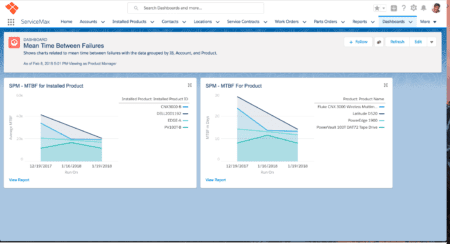This is the second part of a series highlighting the new capabilities and enhancements to ServiceMax Winter ’18. Read the first part here.
What You Need to Know: Field Technicians
Field Inventory Management
Currently, customers use ServiceMax to manage their field inventory and trunk stock through processes defined in the Service Flow Manager (SFM).
Winter ’18 extends these inventory management capabilities and introduces a dedicated mobile experience to simplify the process of making ad-hoc requests for field technicians. They can now easily see the closest inventory location in real time, visualized on a map. And then they can get in touch with another technician, a warehouse or a forward stocking location to request the needed part.
In the back-end, administrators also benefit from the tighter process, which reduces the number of steps for them to enable and control part of the request process. The new capabilities not only significantly improve the user experience in the field, but also directly impact the First Time Fix (FTF) rate and truck-roll related service costs.
To learn more about this critical capability, read this post by Lubor Ptacek.
Performance Improvements for the Service Flow Manager (SFM)
Syncing data between the server and mobile devices, or between the server and your ServiceMax application, keeps vital service information such as work orders, appointments and checklists current. However, transmitting large volumes of data every time a change occurs, a transaction is completed, or a field technician adds or edits a field, takes a toll on system performance.
With Winter ’18, ServiceMax launches two settings that improve the web and mobile user experience:
- Smart Sync for mobile devices:
With the invention of Smart Sync, available as beta version for the FSA app, field technicians no longer need to do a full data sync, which looks at all changes on the client and server, and syncs them up. Smart Sync reduces the time needed for an update by a factor of 10 (compared to a traditional data sync).
How Smart Sync works: From a mobile screen, the technician selects an action e.g. ‘Refresh Work Order’ or ‘Get Price’ from the actions menu. This prompts the records that are visible on the screen –and only these records- to be sent to the server. The server processes the transaction, refreshes the fields that were impacted by it, and subsequently returns the updated field values back to the app. All of this happens in the background without the technician having to go through manual steps such as invoking the full data sync from a separate screen.
- SFM Query Optimizer for the web:
SFM Query Optimizer is a setting that drives an optimized behavior for all ServiceMax business processes. It is targeted at complex projects that contain numerous fields and lots of data. On average, any given transaction such as a ‘Location Update’ only needs to access less than 10 percent of the total number of fields that are on a work order. To improve the performance, instead of transmitting all data fields every time SFM loads or saves, the new settings only updates the added or edited information. This shortens the response times significantly, not only for field technicians but also for all users of the ServiceMax platform.
Usability Features for the FSA App
- Updated calendar user interface
- Native picklist control
- Inline viewer displays attached files without using a third-party app
- Add media files to records by using your activated device camera or by selecting them from the library
- Send files from third-party app to your FSA app
- Service Report print preview
What You Need to Know: Administrators
IoT Integration: Object Mapping Tool
Operationalizing IoT data is a cornerstone for developing proactive maintenance strategies — and it’s almost always a time-consuming effort that requires extensive coding.
Winter ’18 streamlines this process. Now, by mapping fields in a purpose-built, uncomplicated user interface, an administrator can quickly and easily generate ServiceMax objects with an IoT platform — no coding required. This integration can receive IoT data to trigger the creation or update of four objects: Service Request, Case, Work Order, Installed Product.
This point-to-point integration offers a new way for companies to make data from IoT systems such as Predix and Predix APM available for service delivery purposes, reducing the amount of custom code that has to be maintained, and speeding up time-to-value for implementations.
What You Need to Know: Field Service Leaders
Mean Time Between Failures
Unplanned downtime can result in a lot of lost productivity and money and avoiding any unplanned downtime is the mantra that equipment-centric companies live by.
With Winter ’18, ServiceMax adds Mean Time Between Failures (MTBF) as a new, out-of-the-box KPI to its Service Performance Metrics dashboard. MTBF uses work order information associated with an asset to measure the average time a product or device operates between failures. It is used to determine the reliability of a product or asset.

This helps field service leaders to more accurately forecast parts and service manpower, inform engineering decisions regarding change requests and recalls, and ultimately reduce downtimes.
Other Notable New Features
- Schedule Optimization now returns results to dispatchers up to 10x faster than before
- Tags questions on checklists to make them easier to organize and find
- Pre-populates answer-fields on mobile checklists to reduce user errors from manually inputting data
- Enables field technicians to attach video, and images files via the mobile app directly on the checklist
- Imports checklists from external systems
News From Our Partners
Document Generation from Nintex (formerly Drawloop)
Finding documents like manuals, inspection reports, or contracts in one place is crucial for field technicians to efficiently do their job. Simultaneously, they also have to generate documents to keep a record of what they have done for compliance or billing purposes.
In conjunction with this release, ServiceMax from GE Digital is expanding its partnership with Nintex to resell Nintex Document Generation to address these needs. The Nintex solution simplifies the business documents generation process for ServiceMax platform users, while providing an integrated user experience. In just three clicks, a field technician can generate a business document in print quality that draws on data from multiple objects, records, or third-party systems, then preview the PDF, and attach it to a service record.
Customer Community Plus from Salesforce
Together with the Winter ’18 release, ServiceMax from GE Digital expands its strategic partnership with Salesforce and now also resells Customer Community Plus.
In field service, the customer is front and center in everything you do. In fact, the success of your business depends on the strength of your interactions with your customers and their experience with you. And customer communities help you to keep service costs low, your customers happy and ultimately drive top-line revenue.
Through Customer Community Plus, you can now take advantage of new dashboard and reporting functionalities, enhanced sharing capabilities, delegated community administration, and more.
ServiceMax is the only product that provides complete visibility into the parts field inventory including tracking and exchanging of parts in the field. Learn more:
- Register for a webinar on March 1 about the ServiceMax Winter ’18 release.
- View a product demo.
- Learn more about connected field service.
- Learn more about spare parts, returns and depot repair.


I’m currently using the DocGen by Nintex (many custom DDP’s have been desinged), is there anything different with this process that would be different and/or would change the way we license Nintex today based on the Partnetship with ServiceMax?
I am trying to download servicemax winter 18’ but I cannot find on apple app site
What am I doing wrong I am using a iPhone 5
Not sure what went wrong. Please try these direct links:
Winter 18 for iOS is available at https://itunes.apple.com/us/app/servicemax-winter18-for-iphone/id1334011853?mt=8
All ServiceMax apps are listed on https://itunes.apple.com/us/developer/servicemax-inc/id404503176?mt=8
Winter 18 is missing from both Apple and Google
Dan, can you use this instead please:
Apple:
https://itunes.apple.com/us/app/servicemax-classic-for-ipad/id1334024109?mt=8
https://itunes.apple.com/us/app/field-service-app-for-ipad/id1242227075?mt=8
Google:
https://play.google.com/store/apps/details?id=com.servicemax.mobile.svmxandroidclassic
https://play.google.com/store/apps/details?id=com.servicemaxinc.svmxfieldserviceapp
Can you log in to multiple devices at the same time on Service Max Classic? I use both my iphone and ipad for work. I would love to have both logged in at once to see current jobs. Is this possble?
Hi Michael,
It should not be a problem to log in to multiple devices at the same time. Salesforce does impose some limitations, where the original access token which keeps you logged in will eventually get revoked if the same user logs in on 6 different devices, but I don’t believe you’ll have any issues with your scenario.